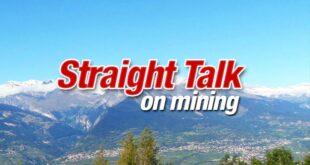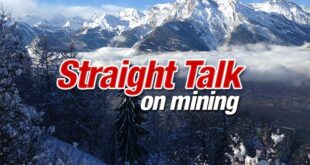Hello out there in cyber land. This is the first in a series of educational essays concerning geology, mining, exploration, and the mining investment scene. I am pleased to see how many people out there want to become more savvy investors. The response to my Gold- Eagle.com and LeMetropolecafe.com articles has been overwhelming, with requests to be put on the mailing list pouring in from 14 countries!! This shows that there is healthy interest out there.
I’m willing to bet that there are more mining analysts out there in the big wide world than Economic Geologists. The prefix “economic” separates us from other geologists such as those who study earthquakes, hunt for groundwater, or look for fossils. Economic geology in its broadest sense concerns anything that can be taken out of the ground at a profit, and economic geologists includes those who explore for, or evaluate deposits of metals, industrial minerals, precious stones, coal, uranium, or oil and gas. In general, the oil and gas game has become so specialized that there is rarely crossover with other fields, so these specialized types are known as “petroleum” geologists. Some economic geologists may have experience in the search and evaluation of various types of commodities; others may specialize in just gold, or diamonds, or platinum. A geologist is generally regarded (and legally defined in many places) as someone who has followed a course of study and obtained a qualification in Geological Science from a recognized university. This separates him or her from a “prospector” or a “geological technician” who may have had no formal training, or has trained at a technical or community college. Geological Engineers may have similar experience to economic geologists, but they have also studied additional subjects like “rock mechanics” and typically enter the scene when a deposit has been found and is in production or feasibility studies. The geologist is typically the one who makes the decisions where to drill, and the engineer is the one who designs the mine.
I am an Economic Geologist – and unapologetic gold bug. I believe that in the face of tanking international stock markets there can be no real explanation for the flat-line behaviour of the gold price other than it is being manipulated. I applaud the efforts of worthies such as Reg Howe, James Turk, Frank Veneroso and Bill Murphy in shedding sunlight on the hitherto shadow-world of central bank gold dealings. However, I believe that there are other sinister and cynical forces out there with designs on keeping the gold price at status quo low levels – just long enough to distress the small and mid-tier producers, so they can be picked off in hostile takeovers. Ditto for the junior miner who makes a new discovery.
I first mentioned this in an August, 2000 LeMetropoleCafe essay, “Major Gold Producers Eating Their Young”. Control of Echo Bay is now in the hands of Franco-Nevada. AngloGold has made a bid for Normandy. Barrick has taken out Homestake. The senior producers claim that industry consolidation is the only survival tactic open to them in light of low gold prices. But think about it for a second: if one of the biggest gold companies out there said it was considering suspending gold sales for a month or two – not because they were in financial duress, but because there was truly too much of a supply out there (like Bobby Godsell of AngloGold claims) – the price would surely spike upwards. Just like what happened to palladium. Instead we get the World Gold Council’s pathetic attempt to promote gold jewellery. Other commodity producers ratchet their production down all the time to tighten the supply – why not gold? Synergies in gold mining? Poppycock!! Normandy and Anglo talk about saving money on a few access roads. Big deal. This is not like Compaq and HP, who are merging for survival sake.
Unlike other metal mining, the gold mining business has always been spread thinly between a few major producers and hundreds of small and mid-tier producers. According to Gold Fields Mineral Services Ltd., last year the top 10 gold producers together accounted for 41% of world production. One of the long-term criticisms of the gold industry has been that the pie has been sliced too many ways. Now, two of those on the list, Homestake and Normandy, will shortly be absorbed. The on-going consolidation in the gold industry will, in time, give a few companies an oligopoly – a de facto monopoly on gold mining. Imagine what a company could do if it controlled more than 50% of world production??? Imagine if we had a Central Selling Organization for gold?? In any case, if such a scheme is afoot it is unravelling, because market forces are coming together to bust open this market.
Two years ago, the president of a junior gold exploration company said to me that he was halting all exploration and going into hibernation mode. I asked him why, since he had great properties and money in the bank. He said that if he did the work, he would have to report the results, and that even if they were great, the press release would vanish into the void. He said that there was no point, if there was no audience out there.
In the last six months the situation has started cautiously, and tentatively, to change. In the last two weeks, one colleague opened a new office and started the paperwork towards a new listing; another invited me to join with some investors in a junior capital pool. This couldn’t have happen during dot.com mania. The market is turning around.
However, we will need to see a sustained gold rally for things to really get going. There is a lot of negativity out there because we’ve seen rallies in gold flame-out after two or three days. Is this part of an orchestrated plot to shake us out? If it is, it can’t function forever. Gold is practically at the same price today as it was at the beginning of 2001. Everyone reading this is aware of the upside potential for gold. It would appear from the price level, in view of wild gyrations in the stock markets, that gold is holding its own. This is an important consideration when so much money is being pulled out of equities and is parked in cash on the sidelines looking for a home. Gold is the ultimate wealth-protector.
The prices of the gold producers are already predicting a rise in the bullion price. Increasingly, there will be opportunities once again for junior companies to raise capital for gold exploration. Eventually, and inevitably one of those junior companies will make a big new discovery and the market will take off. But this time -and for the first time – the focus of the whole world may be on that discovery.
Last year I had a conversation with an analyst, which went something like this:
“Did you invest in Bre-X?”
“Of course not, Bre-X was a scam!”
“Ya, but did you know that?”
“Not entirely, but a couple of things didn’t look right. Their drill plan was all cock-eyed and they were adding ounces a lot faster than was possible. Also, they said they were in a diatreme which was too large to be geologically tenable.”
“You’re an idiot then. You should have got “in” and “out” and made yourself some nice money. A lot of people made a lot of money off of Bre-X.”
The point is not the fact that Bre-X was a scam, but the phenomenon that was Bre-X – that it happened, and it’s ability to capture the imagination of the investing public. The really crazy whacko reserve numbers came out late in the scam – Felderhof’s claim of 120 million ounces is equivalent to the whole of the Carlin Trend, and was just loony. But it is possible that someone will come up with a 10, 15 or even 20 million ounce deposit in some new frontier area sometime in the future. This will become even more likely if junior companies proliferate like rabbits and spread all over the globe. Will it take off like Bre-X did?
Of course, had I invested in Bre-X, I might have had a sudden “cease trade order” descend on my investment, and that might have been the end of it, but because I am a cautious and knowledgeable investor I stayed away from it. I want to make one thing clear – the overwhelming majority of junior mining companies are now prepared to go to extreme lengths to prove that their discoveries are bona fide – way past what were previously considered industry “best practices”. These usually involve numerous arms-length independent studies by recognized consulting firms, chain-of-custody sampling, and avoidance of local or non-accredited assay laboratories. The rogue elements will still be around, but they have mostly moved on to greener pastures. All these measures add to exploration costs, but are part of the new cost of doing business. Another important thing for consideration is that the Bre-X fraud was aided and abetted – probably unknowingly – by brokers and analysts who should have advised more caution. Two big Bre-X investors who got burned, recently settled out of court with a brokerage firm.
We are in a very unusual and perhaps historically unprecedented situation for the junior explorationists. Though the gold price is painfully trying to inch its way back up, and the major producers are doing fairly well in share price since the beginning of 2001, the juniors are still mostly in the tank. This, I believe is a hangover effect from the Bre-X fraud and other copycat schemes. Confidence in the juniors has been shaken, and is still not back. Investors, especially institutional investors, for the time-being are much more comfortable with a producer than with an exploration play. This is a shame, because where you can make the really big bucks has always been in the juniors, and there have been some great success stories in the past decade, like Diamet, Mar-West, Sutton Resources, Arequipa, and Diamond Fields. All these were penny stocks when they made their discoveries. The Mining Business because it is so secretive and highly competitive has never had a good track record of banding together and reinventing itself. Regulatory agencies though, especially the Canadians have made great strides in preventing things like Bre-X from happening again. More about this in a future essay…
Another big factor to consider is the growth in television investment coverage. The stock market used to get a 20 or 30 second mention on the evening news before the sports came on. Now there are entire networks devoted to it. You can pretty well track the major indices in real time on the television. Today, (September 7th) I have heard the gold market mentioned twice on T.V. If junior gold mining stocks start to be mentioned on Bubblevision (and they most certainly will) we could see the gold business tapping into a much wider audience than ever before. The Internet of course is also a very important way of spreading the word, but as advertisers have found, it is much more of an “active” medium, whereas television is much more “passive”. In other words, those who get their information from the Internet are likely to go searching for it – it’s like preaching to the choir – while television brings in a much broader audience of passers-by. Some may come by way of chat-room bulletin boards, but most new converts to gold will probably come by way of the telly. Also, in large part due to television coverage, markets have become much more global. Increasing numbers of foreign gold producers are getting NYSE listings to tap into the American market. There appears to be a fundamental shift away from the historic and regional centres like Johannesburg, Vancouver and Toronto where the mining expertise resides, to New York and London. How do you get information to make an informed investment decision if your broker doesn’t know much about mining? Does it matter what we pick if we find ourselves in the middle of a market “feeding frenzy”? It ALWAYS matters! And you owe it to yourself to become as educated and informed as possible. Question everything!
“A Miner is a Liar who owns a hole in the ground”
The American author and humourist Mark Twain, made this oft-quoted and facetious remark more than a century ago. Every few years it pops up again, usually as the tag line to a newspaper story about some rogue mining scam. Twain had been a miner and prospector long before he became a writer. In fact, he was so bad at mining that he was forced to become a newspaper reporter to supplement his income. A reading of Twain’s mining days in “Roughing It” reveals that he knew virtually nothing about prospecting, and the fact he was “claim jumped” shows he knew little also about mining law. (Another prospectorturned- author, Jack London, was much better at it. His description of gold “pocket mining” in the short story All Gold Canyon is authentic). So it is perhaps with a touch of chagrin, or “sour grapes” that Twain cheerfully denigrated his erstwhile profession. Mining is one of the oldest professions – perhaps truly “the oldest profession”, pre-dating even farming. Cavedwellers must have gathered ochre pigments for their paintings more than 20,000 years ago. Mining though, especially for gold and precious gems, has always had an aura of mystery about it – it captures the imagination, like treasure hunting. Stories about “striking it rich” are part of popular culture. Everyone is familiar with the tales of staking “rushes” and prospectors with little or no formal training – like Twain – finding huge fortunes in Ballarat, the Witwatersrand, the Klondike, or the California Motherlode. It is because of this perception that some investors consider exploration to be rather random and hit-or-miss; and by extension, that investment in junior mining stocks – those companies not yet mining – is a crap-shoot.
If we return to Twain’s pronouncement again, why “liar”? This is because minerals exploration can occasionally be spectacularly lucrative, and anything that is spectacularly lucrative is an invitation to grifters and fraudsters. Twain got caught up in the “great silver excitement” that followed the discovery of the Comstock Lode. For every viable discovery there were 100’s, maybe 1000’s of “prospects”, some being developed by earnest and dedicated prospectors, others by those intent on mining the pockets of the public. As we all know, Twain was rather given to exaggeration. The mining business wouldn’t exist if there were predominantly crooks involved in it – the very reason the small minority of fraudsters have existed is because some companies do indeed strike it big – Very Big. In my own career I have been through the boom cycles that were fathered by the Hemlo gold discovery (1981), the Eskay Creek silver-gold discovery (1988), the Lac de Gras diamond discovery (1990), the Voisey’s Bay nickel discovery (1993), and the La Pierina, Peru, gold discovery (1995). All of these discoveries were legit, and involved junior companies which rose spectacularly in valuation. All of them sparked tremendous land rushes and spawned 100’s of other projects attempting to locate similar riches. Some of these also-ran projects had technical merit, some didn’t.
The other persistent myth out there is that most discoveries are by accident, like Fred LaRose who threw a hammer at a fox and discovered the rich Cobalt silver deposits, or the discovery of the original Dome mine by two prospectors who slipped on the moss-covered outcrop and exposed the quartz, dripping with gold “like candle wax”. The media love Horatio Alger “rags to riches” stories; there’s something egalitarian and democratic about them – like winning the Powerball Lottery. The present day reality of exploration doesn’t capture the headlines the same way. You don’t often see headlines like “induced polarization survey makes new discovery”, or “humus sampling finds bonanza grades”. The truth is, present day exploration requires more than a pick and shovel, a mule, and a gold pan. Discovery essentially relies on selection of prospective real estate, employing people with solid exploration experience and good observational skills, and the following of exploration steps in a sequential and logical progression. Luck may play a part, but serendipity rarely does.
Okay, let’s return to Mark Twain once last time: Perception and truth. What enabled Twain’s typecast miner to “lie”? Many investors out there can understand and evaluate a profit/loss statement, but how do you evaluate an exploration play? The difficulty arises in the special knowledge of – these days – the geologist (the science of geology was still in its infancy when Twain was digging for silver during the US Civil War). Other professions are becoming increasingly specialized, with technical language that is becoming much less accessible to the layman. Think of “dongles” and “routers” in the computer world, or “gene splicing” and “stem cells” in the biotech world. The special language of the geologist is something that has been around for about a century, and to the average investor, mineral exploration may seem like one of the Black Arts. It shouldn’t and needn’t be so.
News You Can Use :
Where to find explanations of some mining terms? Here are two great FREE sources:
- Look at the website for the Northern Miner Newspaper http://www.northernminer.com .You can find a dictionary listed under “tools” on the left side of the screen. Oh, and their short course notes “Geology 101″ is great too. The Northern Miner sells a great little book called “Mining Explained” as well. You won’t find it on their website but if you E-mail or telephone their 1-800 number they’ll tell you all about it.
- Another great source is http://www.infomine.comClick on “dictionary” on the far left hand side of the screen. This is the Dictionary of Mining, Mineral and Related Terms, originally compiled by the now-defunct US Bureau of Mines, in 1996. It contains more than 26,000 terms and definitions.
Unfortunately, there is a presumption out there that exploration companies are poor at what they do. In other words, most of them don’t find much. Statistically, that’s true. In fact, there have been studies by noteworthy economists who suggest that gold exploration is a particularly poor business proposition – but all these studies include all the dud companies as well as the winners, and its a pretty skewed distribution with lots of duds and few winners. During the last boom in junior mining stocks, between 1994-97, the scene was pretty much the same as the recent dot.com boom. Like the business models that didn’t make sense in the dot.com world (remember buying dog food on-line and what a winner concept that was?), there were many projects out there that simply didn’t make sense from a geological point of view, as well as from other perspectives. This is what happens when you have a “feeding frenzy” in the markets; when projects of dubious merit get funding. This is part of business risk and is mitigated in part by choosing companies with professional staff who have a good track record of discovery and management, and who have demonstrated they can create value for shareholders.
Even through the best efforts of geologists, though, sometimes projects just don’t work. This is because in mineral exploration we’re dealing with natural phenomenon. “It can’t be found if the good Lord didn’t put it there”, as some would say. This is “geological risk”. It’s also the reason gold is a “precious” metal and diamonds are “precious” stones – they have rarity value because they are not easy to find in commercial amounts. This risk though can be mitigated by having your project in good, mineral-prospective real estate and by spreading the risk through a number of different concurrent projects. More about that in another issue…
So that’s it for this week. Next week we get down to business.
Topic next week: Standards of disclosure for mineral projects. Canadian National Instrument 43-101 and equivalents in USA, UK and Australia – the reporting rules for mining companies.
******
Putting together a newsletter is a new venture for me, so expect the format and content to evolve over the coming weeks. Your comments are always welcome. Please be assured I won’t be selling your E-mail address to anyone, nor will these essays contain advertising, (except for shameless self-promotion). I don’t intend to make this a “tout sheet’ or a “hot sheet” nor will I provide stock tips or investment advice here. What I will attempt to do is provide some clarity and explanation of the many technical terms which crop up in press releases. I’ll debunk some myths about the gold business, and, hopefully, do my small part to put things back on an even keel. I’m planning on producing this weekly, over the next six months, but right now I forecast that I will be far too busy with a hot gold market six months from now to give this E-Newsletter the attention it deserves. We’ll see how it goes.
Some future topics (in no particular order):
- Free milling, roasting and leaching.
- Making sense of laboratory analysis techniques. What are BLEG’s, AA, ICP, NA and fire assay?
- Negotiating the labyrinth of “resources” “reserves” and “geologically indicated”. Where do you draw the line between a gold “deposit” and a gold “occurrence” or “showing”?
- What really happened at Busang?
- Types of sample: grab, chip, channel, continuous channel. What is chain-of-custody sampling?
- Types of drilling DD, RC, RAB, and core sizes.
- Alluvial gold.
- Types of recovery: gravity, cyanidation, carbon-in-pulp.
- Salting techniques and how to spot them.
- Explaining the geology of the Carlin Trend.
- Mythology and diamond exploration: shedding light on the microdiamond/macrodiamond controversy.
- The Great Diamond Fraud of 1872 and making sure it doesn’t happen again.
- Political risk factors in the mining business.
- Is gold exploration really a risky undertaking?
- Perceptions from industry: where are the new gold deposits going to come from? Where are the most lucrative deposits going to come from? Explaining the Nugget Effect.
- Due Diligence as it relates to work in the Third World.
As well as producing these free essays I run a geological consulting business. For a fee I will provide an in-depth analysis of a mining company or project of your choice. Lots of mining newspapers report the news, but few have the space or technical staff to provide an analysis, so it can be difficult if not impossible to place it in any context, enabling you to make your own informed investment decision. Other services may provide you with every scrap of public domain information about a company, including all their press releases, but no way of compiling it and then cutting through the froth. Newsletters may simply provide you with a few performance charts.
I will soon be launching a parallel “Subscribers Only” newsletter, which will focus each week on 5 companies in the news. It won’t be simply a “buy list”, but my own unique perspective as a practicing geologist – I can’t promise it will always be positive, but it will be “Straight Talk”.
This essay was completed in the early hours of Tuesday, September 11th, 2001, before the tragic events in New York. It was scheduled to go out to you that day. This inaugural issue is dedicated to the memory of those in the investment community who lost their lives in the World Trade Center attack. My deepest condolences go out to the survivors, and to friends and relatives of the victims.
*****
Straight Talk on Mining is provided for information purposes only. Nothing herein is to be construed as a recommendation to buy or to sell any particular security or financial instrument. Nothing herein is to be construed as a recommendation to engage in any particular investment strategy or trading strategy.
The investments discussed herein may be unsuitable for investors depending on their specific investment objectives, financial situation, and risk tolerance. Private investors should obtain the advice of a qualified financial advisor before entering into any transaction.
Straight Talk on Mining is based on information that is generally available to the public. The sources used are believed to be reliable, but because the information and data that they provide are beyond my control, no representation is made that it is complete or accurate. References to other publications and direct links to external Internet sites are sometimes given. The inclusion of any publication, organization or Internet site herein does not imply any endorsement. Straight Talk on Mining has no control over the content of any Internet site that you may reach through links that are provided, nor can their truth, accuracy, or completeness be vouched for.
Straight Talk on Mining is not a financial services company nor is it affiliated with any financial service company in any jurisdiction.
The author/publisher, Dr. Keith M. Barron, is not a qualified financial advisor and is not acting as such in this publication. The accuracy of any legal term or definitions used herein should be verified with your legal advisor or the appropriate government agency.
 Straight Talk On Mining Insights on mining from economic geologist Dr. Keith Barron.
Straight Talk On Mining Insights on mining from economic geologist Dr. Keith Barron.





Hard to believe Mr Barron’s first article was on 9/11. It wasn’t too long after that that I, by exploring the internet for investment ideas, came across some gold websites, and slowly and painstakingly began self-educating about the role of gold in the world. It will be interesting to read these articles and look back at what we were thinking. As Mr. Barron points out, he noticed things began to change about March of 2001 in the junior market. Today, in Oct of 2015, things look as bad as ever in the junior market. However, I think part of this is due to the need to take impairment losses due to the continued drop in the price of gold. Once a year goes by since the writedowns, and we no longer see the effect on the annual EPS, then I think that the gold market will start to pick up in earnest. I am predicting that starting in September 2016, we will have lift-off towards a bull market of historic proportions in gold. I wish us all to be on board. Go Teranga!